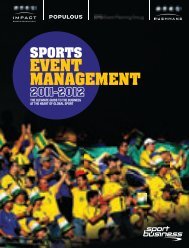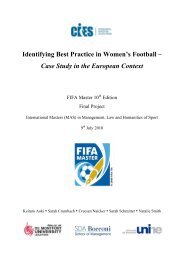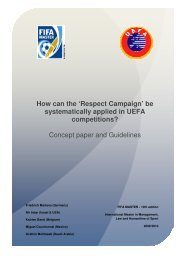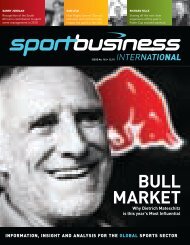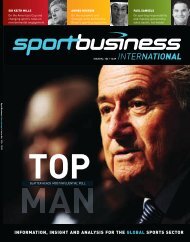Sports Marketing & Sponsorship - FIFA/CIES International University ...
Sports Marketing & Sponsorship - FIFA/CIES International University ...
Sports Marketing & Sponsorship - FIFA/CIES International University ...
- No tags were found...
Create successful ePaper yourself
Turn your PDF publications into a flip-book with our unique Google optimized e-Paper software.
European football under close scrutinyexpand their sources of income, particularly outside ofsport. This strategy can be seen through thedevelopment of brands (Kapferer, 1996; Aaker,1994), illustrated by the plethora of products carryingteam logos, names and mascots being sold throughmajor distribution channels or specialised shopsacross the world. This overall commercialisationassociated with football is made quite obvious both tothe general public and to stakeholders, who witnesscostly transfers and contracts. Players, while benefitingfrom this commodification, have become goods to betraded and are sold to the highest bidder. Federalsporting authorities have also extensively developedtheir commercial activities. <strong>FIFA</strong> announced that thelast 2006 World Cup in Germany has generated arevenue of €1.86 billion and for 2008 a turnover ofUSD 957 million (€719,5 million) and a profit ofUSD 184 million (€138 million). UEFA hasannounced an estimated revenue of €1.3 billion forthe 2008 European Championship, mostly from thesale of television broadcasting rights (€900 million).We can therefore see that this mass marketing offootball is affecting sporting organisations that used tobe non-profit organisations. With this in mind, what isthe part played by ethics in the marketing strategies ofthese organisations?For sporting organisations, ethics is a key valueunder close scrutinyBeyond the general consideration of ethics in thebusiness world, some sporting organisations havemade it a central element in their strategy (Durand &Rouvrais-Charron, 2006). This choice involves aconstraint that is two-fold. With these organisationshaving social goals, it is imperative that they protectsporting values; ethics is a key element in theiridentity. In addition, pressure from their partners andstakeholders forces organisations to put ethicalconsiderations at the centre of their communicationactivities. Ethics thus catalyses strategy. In ethicalterms, we may suppose that international sportingorganisations tend to oscillate between commitmentand opportunism. We are then led to ask which of thedecisions taken are a result of giving in to pressure,and which ones come from a real desire to act. Wecan begin to answer this question if the internationalsporting movement is considered as an integral part ofsocietal evolution. Along these lines, we must firstclarify the dilemma sporting that organisations face,especially in football: adapt or die.While sporting myths may always have been a keyelement in this sector, a critical movement gainedmomentum in sport as a whole in the 1990s, andwas sometimes expressed in extreme words (Brohm etal, 2004): “By a quasi-mystical invocation of the‘eternal values of sport’, this ideology seeks selfprophesyingstatus by reducing the gap between thereality of capitalist practices in the production ofsporting events and the celestial sphere of the ‘grandidea of sport’.”As Bayle & Durand (2004) noted, there is “agrowing gap between ethics and behaviour” amonghistorical sporting authorities. As a result, thelegitimacy of international sport’s governing bodies canno longer be based on a rhetoric that has more to dowith ideology than with reality (Figure 2).Figure 2 represents a self-regulating system. Thecommunity sends two types of signal. The first targetsprivate actors. It defines some demands mainly guidedby commercial motivations. The second type of signalsconcerns social matters and is directed towards publicstakeholders. There is an attempt at a greater code ofethics from the sporting movement, and in particularfrom the world of football, for political reasons. Thesepressures oblige sporting figures, whose principles arerather similar, to apply suitable marketing tools torespond to these various demands. Moreover, thesemarketing tools relate to the actions on the morallevel, for example the fights against doping,corruption, xenophobia or violence in stadia. They alsoconsist of talks and communication operations withsocial figures. Therefore, for example, the officialreports of sporting authorities propose the role of sportas a tool for social integration and the protection ofbasic values before any other elements. It cantherefore be seen that sporting figures are compelledRESEARCH PAPER● APRIL 2009 ● <strong>International</strong> Journal of <strong>Sports</strong> <strong>Marketing</strong> & <strong>Sponsorship</strong>237






